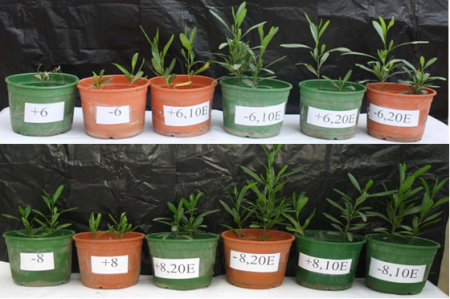
The effects of EDDHA and Ca on suppression of F. solani and hopbush growth improvement
Abstract
The effect of various levels of soil pH (6, 8) and EDDHA concentrations (0, 10 and 20 mmol/L) on disease severity of F. solani-infested plants was determined. EDDHA significantly (p<0/05) reduced disease severity by F. solani and increased other evaluated characteristics of root at both pH levels. Also F. solani-infested plants grown at pH= 6 and different EDDHA concentrations showed more disease severity andpoorer growth characteristics compared with plants grown at pH= 8.  In other experiments growth of non-infested plants at pH= 6 and different levels of EDDHA was better than that at pH= 8. Study on the effects of calcium and EDDHA on the same characteristics in infested and non-infested soils at pH 6 showed that the maximum. decrease in disease severity (6.6%) as well as highest growth characteristics were obtained when both EDDHA and Ca were applied together simultaneously. Greatest disease severity and the lowest growth characteristics were observed in the absence of EDDHA and Ca compared to other treatments. Results of the effect of EDDHA concentrations and Ca at soil pH= 8 showed that the growth characteristics increased and disease severity was reduced significantly.
Full Text:
PDFReferences
- Rajamanickam, V., Rajasekaran, A., Anandarajagopal, K., Sridharan, D., Selvakumar, K., Stephen Rathinaraj, B. (2010). Anti-diarrheal activity of Dodonaea viscosa root extracts. International Journal of Pharma and Bio Sciences, (1): 182-185.
- Muthukumaran, P., Hazeena Begumand, V., Kalaiarasan, P. (2001). Anti-diabetic activity of Dodonaea viscose leaf extracts. International Journal of PharmTech Research 3(1): 136-139.
- Kavianpay, A. (1998). Isolation and identification of jungle causal root rot and damping-off in forest nursery seedling in Khuzestan. Master thesis, Agriculture College of Chamran university, Ahvaz, Iran.
- Farokhi Nejad, R. (1993). Induction of soil suppressiveness to Fusarium wilt disease of pea. Ph.D Dissertation. Colorado State University.
- Michael, M.M. (1997). Control of Fusarium crown and root rot on tomato seedlings using synthetic iron chelators and phenolic compounds found in lettuce roots. Submitted in partial fulfillment of the requirements for the degree of Master of Science. Department of Plant Sciences, the University of Western Ontario London, Ontario.
- Scher, F.M., Baker, R. (1982). Effect of Pseudomonas Putida and a synthetic iron chelator on induction of soil suppressiveness to Fusarium wilt pathogen. Phytopathology 72: 1567-1573.
- Scher, F.M., Baker, R. (1985). The role of competition for iron and carbon in suppression of chlamidospore germination of Fusarium spp.by Pseudomonas spp. Ecology and Epidemiology 75: 1053-1059.
- Havlin, J.L., Tisdale S.L., Nelson, W.L., Beaton, J.D. (2013). Soil Fertility and Fertilizers. 8nd Ed., Prentice Hall.
- Gasemi, S., Khoshgoftarmanesh, A.H., Afyuni, M., Hadadzadeh, H. (2013). The effectiveness of foliar application of synthesized zinc-amino acid chelates in comparison with zinc sulfate to increase yield and grain nutritional quality of wheat. European journal of agronomy 45, 68-74.
- Saikia, R., Srivastava, A.K., Singh, K., Arora, D.K. and Lee, M.L. 2005. Effect of Iron availability on induction of systemic resistance to Fusarium wilt of chickpea by Pseudomonas spp. Mycobiology, 33 (1): 35-40.
- Jones, J.P. and S.S. Woltz. (1972). Effect of soil pH and micronutrient amendments on Verticillium and Fusarium wilt of tomato. Plant Disease Reporter 56:151-153
- Burgess, L.W., Summerell, B.A., Bullock, S., Gott, K.P., Backhouse, D. (1994). Laboratory manual for Fusarium research. 3ndEd. Fusarium research laboratory department of crop sciences., University of Sydney and Royal Botanic Gardens.
- Gupta, P.K. (2009). Soil, plant, water and fertilizer analysis. Agrobios.
- Kim, D.S., Cook, R.J., Weller, D.M. (1997). Bacillus sp. L324-92 for biological control of three root diseases of wheat grown with reduced tillage. Phytopathology 87: 551-558.
- Lindsay, W.L. (2001). Chemical equilibria in soils. The Blackburn Press.
- Jones, J.P., Woltz, S.S., Scott, J.W. (1990). Factors affecting development of Fusarium crown and root rot. Proceedings of the Florida State Horticultural Society 103: 142-148.
- Woltz, S.S., Jones, J.P., Scott, J.W. (1992). Sodium chloride, nitrogen source, and lime influence Fusaritun crown and root rot severity in tomato. HortScience 27: 1087-1088.
- Elad, Y., Baker, R. (1985). The role of competition for iron and carbon in suppression of chlamydospore germination of Fusarium spp. by Pseudomonas spp. Phytopathology 75: 1053-1059.
- Tan, K.H. (2010). Principles of soil chemistry. 4nd Ed, CRC Press.
- Corden, M.E. (1965). Influence of calcium nutrition on Fusarium wilt of tomato and polygalacturonase activity. Phytopathology 76: 401-406.
- Keane, E.M., Sackston, W.E. (1970). Effects of boron and calcium nutrition of flax on Fusarium wilt. Plant Science 50: 415-422.
- Everett, P.H., Blazquez, C.H. (1967). Influence of lime on the development of Fusarium wilt of watermelons. Florida State Horticultural Society 2845: 143-148.
Refbacks
- There are currently no refbacks.
